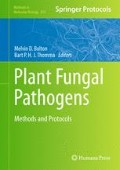Abstract
Many characterized fungal effector proteins are small secreted proteins. Effectors are defined as those proteins that alter host cell structure and/or function by facilitating pathogen infection. The identification of effectors by molecular and cell biology techniques is a difficult task. However, with the availability of whole-genome sequences, these proteins can now be predicted in silico. Here, we describe in detail how to identify and characterize effectors from a defined fungal proteome using in silico techniques.
Access this chapter
Tax calculation will be finalised at checkout
Purchases are for personal use only
References
Metkzer ML (2010) Sequencing technologies – the next generation. Nat. Rev. Genet. 11, 31–46
Miller JR, Koren S and Sutton G (2010) Assembly algorithms for next-generation sequencing data. Genomics 95, 315–327
Martinez D, Grigoriev I and Salamov A (2010) Annotation of protein-coding genes in fungal genomes. Appl. Comput. Math. 9, 56–65
Finn RD, et al (2010) The Pfam protein families database. Nucl. Acid. Res. 38, 211–222
Zdobnov EM and Apweiler R (2001) InterProScan - an integration platform for the signature-recognition methods in InterPro. Bioinform. 17, 847–848
Conesa A, et al (2005) Blast2go: a universal tool for annotation, visualization and analysis in functional genomics research. Bioinform. 21, 3674–3676
Götz S, et al (2008) High-throughput functional annotation and data mining with the Blast2GO suite. Nucl. Acid. Res. 36, 3420–3435
Altschul SF, et al (1990) Basic Local Alignment Search Tool. J. Mol. Biol. 215, 403–410
Nielsen H, et al (1997) Identification of prokaryotic and eukaryotic signal peptides and prediction of their cleavage sites. Protein Eng. 10, 1–6
Bendtsen JD, et al (2004) Improved prediction of signal peptides: SignalP 3.0. J. Mol. Biol. 340, 783–795
Käll L, Krogh A and Sonnhammer ELL (2004) A combined transmembrane topology and signal peptide prediction method. J. Mol. Biol. 338, 1027–1036
Horton P, et al (2007) WoLF PSORT: protein localization predictor. Nucl. Acid. Res. 35, 585–587
Emanuelsson O, et al (2007) Locating proteins in the cell using TargetP, SignalP and related tools. Nat. Protocol. 2, 953–971
Nakai K and Horton P (2007) Computational prediction of subcellular localization. Method. in Mol Biol. 390, 429–466
de Jonge R, et al (2010) Conserved fungal LysM effector Ecp6 prevents chitin-triggered immunity in plants. Science 329, 953–955
Krogh A et al (2001) Predicting transmembrane protein topology with a hidden markov model: application to complete genomes. J. Mol. Biol. 305, 567–580
Käll L, Krogh A and Sonnhammer ELL (2007) Advantages of combined transmembrane topology and signal peptide prediction--the Phobius web server. Nucl. Acid. Res. 35, 429–432
Horton P and Nakai K (1999) Psort: a program for detecting sorting signals in proteins and determining their subcellular localization. TIBS 24, 34–xx
Nakai K and Kanehisa M (1992) A knowledge base for predicting protein localization sites in eukaryotic cells. Genomics 14, 879–911
Bannai H, et al (2002) Extensive feature detection of N-terminal protein sorting signals. Bioinform.18, 298–305
Casadio R, Martelli PL and Pierleoni A (2008) The prediction of protein subcellular localization from sequence: a shortcut to functional genome annotation. Brief. Func. Genom. Proteom. 7, 63–73
Hawkings J and Boden M (2006) Detecting and sorting targeting peptides with neural networks and support vector machines. J. Bioinform. Comput. Biol. 4, 1–18
Nair R and Rost B (2005) Mimicking cellular sorting improves prediction of subcelluar localization. J. Mol. Biol. 348, 85–100
Pierleoni A, et al (2006) BaCelLo: a balanced subcellular localization predictor. Bioinform. 22, 408–416
Klee EW and Sosa CP (2007) Computational classification of classically secreted proteins. Drug. Discov. Today 12, 234–240
Klosterman S, et al (2011) Comparative genomics yields insights into niche adaptation of plant vascular wilt pathogens. PLoS Pathog 7: e1002137
van den Wymelenberg A, et al (2006) Computa-tional analysis of the Phanerochaete chrysosporium v2.0 genome database and mass spectrometry identification of peptides in ligninolytic cultures reveal complex mixtures of secreted proteins. Fungal Genet. Biol. 43, 343–356
Lee SA, et al (2003) An analysis of the Candida albicans genome database for soluble secreted proteins using computer-based prediction algorithms. Yeast 20, 595–610
Choi J, et al (2010) Fungal secretome database: Integrated platform for annotation of fungal secretomes. BMC Genomics 11, 105–119
Lum G and Min XJ (2011) FunSecKB: the fungal secretome knowledgebase. Databases (Oxford) 2011, bar001
Cantarel BL, et al (2009) The Carbohydrate-Active EnZymes database (CAZy): an expert resource for Glycogenomics. Nucl. Acid. Res. 37, 233–238
Winnenburg R, et al (2006) PHI-base: a new database for pathogen host interactions. Nucl. Acid. Res. 34, 459–464
Rep M (2005) Small proteins of plant-pathogenic fungi secreted during host colonization. FEMS Microbiol. Lett. 253, 19–27
Acknowledgments
This research was supported by a Vidi grant of the Research Council for Earth and Life Sciences (ALW) of the Netherlands Organization for Scientific Research (NWO), by the European Research Area–Network (ERA-NET) Plant Genomics and by the Centre for BioSystems Genomics (CBSG), which is part of the Netherlands Genomics Initiative and NWO.
Author information
Authors and Affiliations
Corresponding author
Editor information
Editors and Affiliations
Rights and permissions
Copyright information
© 2012 Springer Science+Business Media, LLC
About this protocol
Cite this protocol
de Jonge, R. (2012). In Silico Identification and Characterization of Effector Catalogs. In: Bolton, M., Thomma, B. (eds) Plant Fungal Pathogens. Methods in Molecular Biology, vol 835. Humana Press. https://doi.org/10.1007/978-1-61779-501-5_25
Download citation
DOI: https://doi.org/10.1007/978-1-61779-501-5_25
Published:
Publisher Name: Humana Press
Print ISBN: 978-1-61779-500-8
Online ISBN: 978-1-61779-501-5
eBook Packages: Springer Protocols

